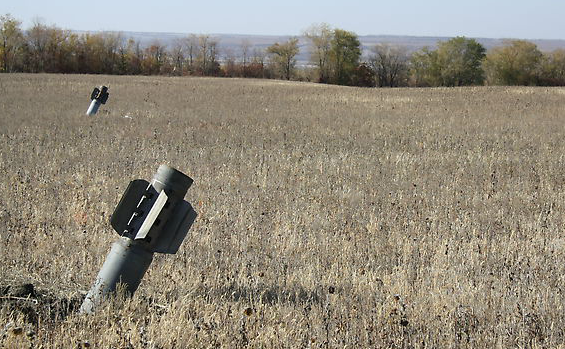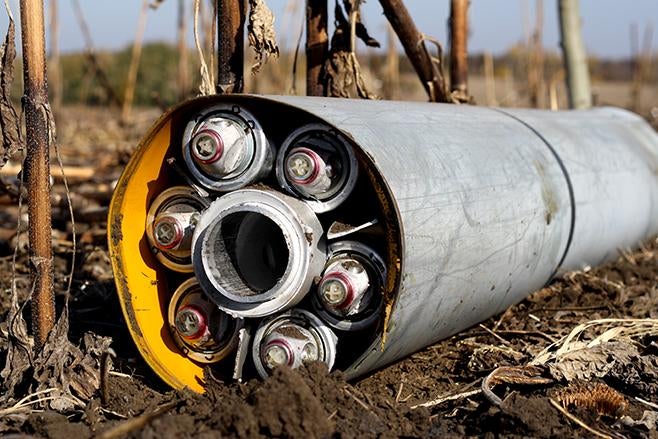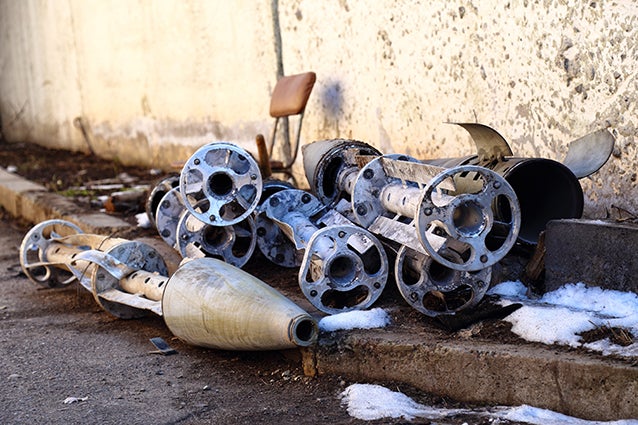Kyiv Government Responsible for
2014 Cluster Attacks on Donetsk
Human Rights Watch
BERLIN (October 20, 2014) — Ukrainian government forces used cluster munitions in populated areas in Donetsk city in early October 2014, Human Rights Watch said today. The use of cluster munitions in populated areas violates the laws of war due to the indiscriminate nature of the weapon and may amount to war crimes. During a week-long investigation in eastern Ukraine, Human Rights Watch documented widespread use of cluster munitions in fighting between government forces and pro-Russian rebels in more than a dozen urban and rural locations.
While it was not possible to conclusively determine responsibility for many of the attacks, the evidence points to Ukrainian government forces’ responsibility for several cluster munition attacks on Donetsk. An employee of the International Committee of the Red Cross (ICRC) was killed on October 2 in an attack on Donetsk that included use of cluster munition rockets.
“It is shocking to see a weapon that most countries have banned used so extensively in eastern Ukraine,” said Mark Hiznay, senior arms researcher at Human Rights Watch. “Ukrainian authorities should make an immediate commitment not to use cluster munitions and join the treaty to ban them.”
Cluster munitions contain dozens or hundreds of smaller munitions, called submunitions, in a container such as a rocket or a bomb. After launch, the container opens up dispersing the submunitions which are designed to explode when they hit the ground.
The submunitions are spread indiscriminately over a wide area, often the size of a football field, putting anyone in the area at the time of attack, whether combatants or civilians, at risk of death or injury. In addition, many of the submunitions do not explode on contact, but remain armed, becoming de facto landmines. Any location contaminated with dud submunitions remains hazardous until cleared by deminers.
To date, 114 countries have joined the treaty that comprehensively bans cluster munitions because of the danger they pose to civilians. Ukraine has not joined the treaty.
There is particularly strong evidence that Ukrainian government forces were responsible for several cluster munition attacks on central Donetsk in early October, Human Rights Watch said. In addition to evidence at the impact site indicating that the cluster munitions came from the direction of government-controlled areas southwest of Donetsk, witnesses in that area said that they observed rockets being launched toward Donetsk on the times and days when cluster munitions struck the city.
A New York Times journalist tracked down several rockets in that area, which appeared to have malfunctioned and fallen to the ground shortly after they were launched, clearly establishing the flight path of the rockets.
In the 12 incidents documented by Human Rights Watch, cluster munitions killed at least 6 people and injured dozens. The real casualty number from use of cluster munitions in the conflict is probably higher, Human Rights Watch said, since it has not investigated all allegations of cluster munition use. Also, in some cases, it was not possible to determine what weapon caused the death or injury because several types of explosive weapons were used at the same time in the same area.
Human Rights Watch identified the cluster munitions by the distinctive crater and fragmentation pattern that submunitions create when they explode, by remnants of the submunitions found at the impact sites, and by remnants of the rockets found in the vicinity. Several of these remnants included markings that allowed for positive identification of the weapon.
Human Rights Watch found evidence of surface-fired 220mm Uragan (Hurricane) and 300mm Smerch (Tornado) cluster munition rockets. Human Rights Watch researchers observed and photographed the remnants of the cargo sections of 16 Uragan and 6 Smerch cluster munition rockets. Altogether, these 22 rockets would have contained 912 individual fragmentation submunitions. The total number of cluster munition rockets used so far in the conflict is unknown.
The government of Ukraine has neither confirmed nor denied using cluster munitions in eastern Ukraine. It has not responded to a letter sent by the Cluster Munition Coalition in July or a letter sent by Human Rights Watch on October 13.
Ukrainian forces should immediately make a commitment to not use cluster munitions and to investigate and hold accountable any personnel responsible for firing cluster munitions into populated areas. Ukraine should accede to the treaty banning their use, Human Rights Watch said.
While not conclusive, circumstances indicate that anti-government forces might also have been responsible for the use of cluster munitions, Human Rights Watch said.
Human Rights Watch also called on Russia to make an immediate commitment to not use cluster munitions and to accede to the cluster munitions treaty.
“Firing cluster munitions into populated areas is utterly irresponsible and those who ordered such attacks should be held to account,” Hiznay said. “The best way for the Ukrainian authorities to demonstrate a commitment to protect civilians would be an immediate promise to stop using cluster munitions.”
Documented Cluster Munition Use in Donetsk
At least five Uragan cluster munition rockets containing submunitions struck central Donetsk in early October 2014, based on evidence Human Rights Watch gathered. The evidence overwhelmingly indicates that these rockets were fired from government-held areas near the village of Novomykhailivka, southwest of Donetsk. At the time of the attacks rebel forces were in control of Donetsk, and government and rebel forces were officially observing a truce agreed on September 5. Nevertheless active fighting continued around the airport, approximately 6 kilometers from the cluster munition impact sites.
Rebel forces were also present around various government institutions in Donetsk, and all the cluster munition attacks in Donetsk took place within one kilometer of a government institution apparently in use by rebels. Rebel fighters on guard did not allow Human Rights Watch to enter the zone around the institution building. Human Rights Watch observed a vehicle with a twin-barreled anti-aircraft cannon mounted on the back in the zone around the institution but has no evidence as to whether rebel forces were ever firing from this location.
Rebel forces, as any party to a conflict, are required by the laws of war to take all feasible precautions to avoid deploying in densely populated areas. This does not however change the indiscriminate, and unlawful, nature of the use of cluster munitions in populated areas. Violations of the laws of war by one party to the conflict do not justify violations by the other party.
Shortly after 5 p.m. on October 2, submunitions hit three areas southwest of Universitetskaya street in central Donetsk. The location of the submunitions in three separate areas indicates that they came from three different rockets. Human Rights Watch previously documented that rebel fighters were using a nearby dormitory, but did not determine whether this was still the case at the time of the attack.
One payload of submunitions struck the roof and surrounding area of a supermarket at 80A Unversitetskaya street. Human Rights Watch identified 15 impact sites on the supermarket roof and 9 impact sites adjacent to the supermarket. A larger crater on the northern corner of the supermarket was probably caused by a piece of the weapon such as the rocket motor.

Cluster bomb victim, Laurent DePasquier.
Thirty-eight-year-old Laurent DuPasquier, a Swiss employee with the International Committee of the Red Cross who was standing outside the organization’s office in the same building complex as the supermarket, was killed during the attack in which cluster munition rockets were used. An investigation has reached no final determination as to the exact causes of his death. Human Rights Watch documented the presence of two craters, about three meters apart, in front of the ICRC office, which appeared consistent with cluster submunition explosions.
DuPasquier’s body was found between the two craters. Human Rights Watch also found pre-formed fragments of a 9N210 submunition and a piece of the ring that attaches the stabilization fins to the submunition about 20 meters from the ICRC office.
At about the same time as submunitions hit the supermarket, submunitions from a second Uragan cluster munition rocket struck a paved road just southeast of the building at 94 Universitetskaya street. Human Rights Watch documented one large crater at the site and about a dozen craters nearby. The proximity of the craters indicates that the munition had malfunctioned, opening up the cargo section of the rocket later than normal and therefore spreading the submunitions over a much smaller area than normal.
A New York Times journalist who examined the area the day following the attack photographed an unexploded submunition and numerous remnants of submunitions, including the characteristic black plastic liner that holds the 2-gram pre-formed fragments inside the 9N210 submunition.

Submunitions from a third rocket hit on and around the building at 100B Universitetskaya street. Human Rights Watch documented at least three submunition impact craters close to the building and discovered the cargo section of an Uragan cluster munition rocket, the part of the rocket that holds the submunitions before they are dispersed, lodged into the ground among bushes close to the southeastern side of the building. Local residents said that many of the submunitions had hit the roof, but Human Rights Watch was not able to access it.
Submunition impact craters close to buildings in the three sites make it unlikely that the cluster munition came from the west, north, or east. The large crater in the second location indicated that the rocket had come from the southwest. This is the only direction consistent with all the impact craters, and therefore points to use by Ukrainian forces.
Two witnesses corroborated that the October 2 cluster munition rockets were fired at Donetsk from the southwest. A local resident who was driving through the village of Novomykhailivka in the late afternoon of October 2 said that he saw several rockets fired from south of the village. Shortly afterward, he said, his wife called him from the city saying that rockets had hit central Donetsk.
A local resident in Solodke, a village southwest of Novomykhailivka, told Human Rights Watch that she saw rockets fired from a position northwest of Solodke. From their different vantage points the two witnesses appeared to describe the same launching position inside an area under the control of Ukrainian government forces.
Also on October 2, submunitions from another Uragan cluster munition rocket struck the building of the Mountain Rescue Service, at 157 Artem street in Donetsk. Human Rights Watch inspected remnants of the rocket outside the building, including one with the markings for an Uragan cluster munition rocket that delivers 9N210 submunitions, as well as several impact craters of submunitions. A part of the rocket penetrated the roof, lodging in the floor in a third-floor office.
In the morning of October 5, at least two Uragan cluster munition rockets struck the fifth subdistrict of the Kyivskyi district in central Donetsk. Submunitions from one rocket struck the intersection between Raduzhnaya street and Zvyagilskogo street.
Human Rights Watch documented 11 submunition impact craters on Zvyagilskogo street and fragment patterns on nearby fences consistent with the use of Uragan cluster munition rockets. Human Rights Watch also found remnants of submunitions at the site.
The attack injured a 37-year-old man who was working in his backyard. He is still recovering from his injuries in a hospital. He told Human Rights Watch:
At first I did not even realize what happened. I heard a loud bang, my ears were blocked. I felt a jolt in the back, and was thrown forward two or three meters. I was covered with dust and earth. It was like a wave. When my hearing recovered, I began to rise slowly. And then I felt something sticky running down my back and leg. I realized that it was blood.
At the hospital, doctors discovered fragments in his leg, back, and hand. One fragment penetrated his lung. He showed Human Rights Watch an X-ray showing three identical fragments in his chest and shoulder. Human Rights Watch identified the fragments as the 2-gram pre-formed fragments of a 9N210 submunition, which are only delivered by Uragan cluster munition rockets.
A second cluster munition struck the residential area between Parkivska street and Kosiora street, about 500 meters west of the first impact site. Human Rights Watch identified several impact craters and local residents showed Human Rights Watch submunition remnants they had found after the attack. At least one civilian was injured in his leg by a fragment.
At the same time as those two attacks, there was an attack nearby on Kalmana street, setting at least two houses on fire. Human Rights Watch was not able to conclusively determine that this attack was with cluster munition rockets.
A video of a rocket remnant lodged in the ground near 22 Kosiora street indicates that the cluster munitions were fired from the southwest. Supporting this finding, a local resident in Novomykhailivka, southwest of Donetsk, told a New York Times journalist that he had seen rockets launched from a position south of village in the morning of October 5.
Luhansk, Ukraine, 2.5.2014: Clusterbomb Remains
A New York Times journalist tracked down a location south of Novomykhailivka where residents had discovered rocket remnants in a field. During a visit to the field, Human Rights Watch researchers and the journalist discovered the remnants of three Uragan cluster munition rockets and one Smerch rocket that had apparently malfunctioned shortly after launch.
Two of the Uragan rockets still contained their payload of 9N210 submunitions. The presence of these misfired cluster munition rockets clearly establishes the flight path of the attack, confirming that the rockets were fired form a government-held area south of Novomykhailivka.
READ the full report online at this link.
Related News:
“Cluster Munition Use in Russia-Ukraine War,” Human Rights Watch, May 29, 2023.

